A look at the projected 2021 forecast for key HR service market segments.
By Pete Tiliakos, Liz Rennie, and Nikki Edwards
Each year, NelsonHall takes a look at the activity of the HR services market to compile the top trends and predict a future outlook for the coming year. 2020 was a year like no other and COVID-19 has had a large impact on all business processes.
This year’s forecast shares how the global pandemic shaped recruitment process outsourcing (RPO) and managed service programs (MSP), learning, cloud HR transformation services, benefits administration, payroll services, and global employer of record (EoR) services, and what is likely to come in 2021.
Recruitment Services in 2020
The initial COVID-19 lockdown required organizations to pivot to remote working and to leverage technology to enable overall business continuity. This single event exposed organizations’ shortfalls in their digital capabilities and ability to handle a crisis.
For RPO and MSP partners, 2020 was an opportunity to shine as they supported their clients through COVID-19 while navigating in-house challenges brought on by the pandemic. Recruitment partners significantly invested in and launched next-generation technology, including multifunctional, high-volume, internal talent platforms that are mobile, fully automated, and artificial intelligence (AI)-enabled. They also enhanced their service delivery with customer experience teams, tech success teams, and flexible resourcing teams, which proved timely.
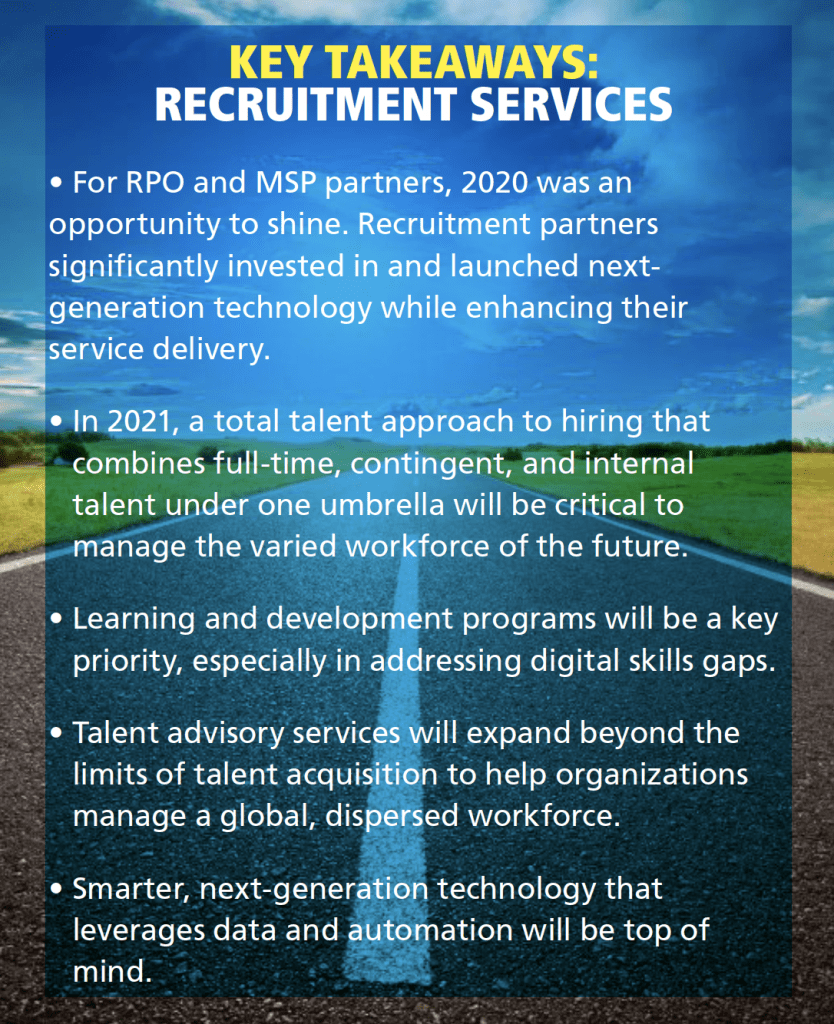 Recruitment service providers stepped up to advise organizations on which digital tools to deploy to enable remote hiring and onboarding of talent. Keeping clients informed was top of mind, with partners setting up information services around working from home, staying safe, and maintaining employee well-being.
Recruitment service providers stepped up to advise organizations on which digital tools to deploy to enable remote hiring and onboarding of talent. Keeping clients informed was top of mind, with partners setting up information services around working from home, staying safe, and maintaining employee well-being.
Taskforces were set up to re-allocate resources to meet organizations’ urgent hiring ramp-ups (particularly in healthcare, pharmaceuticals, and food retail), while supporting clients whose organizations were scaling back or extending services around outplacement and reskilling or upskilling. By the third quarter of 2020, with remote hiring and working looking likely to become the new normal, recruitment partners began supporting their clients with mid- to long-term talent acquisition planning.
2021 HR Outlook: Recruitment Services
While organizations may remain reluctant to hire amid economic uncertainty and choose to focus on essential recruitment only, they have come to realize that they cannot single-handedly navigate the challenges they face. They need support to help them strategize and execute plans to ensure they are fit for the future, so there are opportunities for recruitment providers to thrive.
In addition to the existing talent acquisition solutions, services, and technologies that partners offer, there are several interconnected areas where recruitment service providers could make an additional impact in 2021:
- A holistic, total talent approach to hiring. NelsonHall research showed that 90% of major enterprises recognize the need to embrace a holistic approach to talent acquisition that encompasses full-time, contingent, and internal talent. This is especially critical given that organizations are considering using contingent workers, such as freelancers and gig workers, over full-time workers to avoid long-term employment costs. Service providers already offering total talent solutions are in a stronger position to support their clients, as they can vary the proportion of each delivery channel based on changing demands and relocate resources accordingly. With the need for worker compliance intensifying, giving organizations better visibility into data concerning their internal talent is a growth area.
- Building talent by upskilling and reskilling workers. While organizations will continue to seek talent with skills that are in short supply, employers will eventually face the reality of skill sets being augmented or replaced by automation, requiring upskilling or reskilling programs for affected workers. The “build” element of the “buy, borrow, build, and bot” approach to talent acquisition has never been so important. The COVID-19 pandemic highlighted how organizations’ digital skills fall woefully short of what is required for 2021 and the need to address this skills gap in the workforce. All recruitment partners have a role to play in skills development and can embrace the opportunity uniquely according to their client base and their specific needs.
- Expansion of talent advisory services. It is highly unlikely that the world of work will return to its pre-COVID-19 state. With a more highly distributed and flexible workforce here to stay, RPO and MSP providers can expand their portfolios to offer services around the future of work. One opportunity is providing employer branding and recruitment marketing services that focus on building a compelling employer value proposition by showcasing values demonstrated through the pandemic.
Opportunities also abound in areas beyond talent acquisition, encompassing broader HR and organizational issues. Consulting can cover working with a fully remote, globally spread workforce, addressing topics such as technology; employee communications; employee engagement; workforce well-being and safety; workplace redesign; business continuity planning; and building corporate resilience.
- Next generation platforms and tools. In readiness for the new era of work, recruitment partners are investing in data; AI-based predictive analytics (for example, the impact of automation on skills augmentation or replacement); intelligent automation that looks at workflows and bottlenecks; niche human clouds; and learning technology for reskilling or upskilling. Additionally, chatbots, voice-enabled tools, and the use of AI for resume parsing, candidate matching, and assessments will continue apace.
Learning Services in 2020
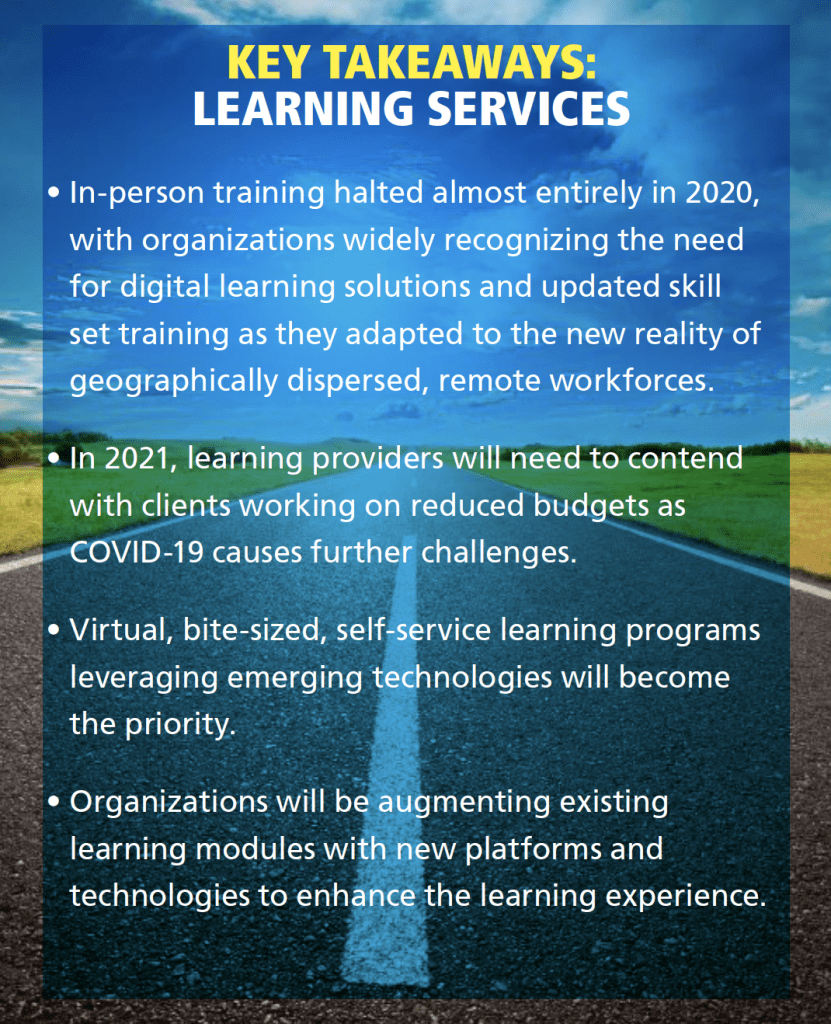 The initial COVID-19 lockdown saw the sudden cessation of in-person training. Organizations sought immediate support from their learning partners as they scrambled to get training content onto cloud-based, peer-to-peer software platforms in a bid to continue planned training, often for employee onboarding and business compliance needs. The priority was to continue training, irrespective of whether the content was suitable for digital delivery. Learning partners also saw increased demand for specific skills training, notably around working and managing remotely, time management, maintaining well-being, and reskilling and upskilling, depending on the impact of COVID-19 by sector.
The initial COVID-19 lockdown saw the sudden cessation of in-person training. Organizations sought immediate support from their learning partners as they scrambled to get training content onto cloud-based, peer-to-peer software platforms in a bid to continue planned training, often for employee onboarding and business compliance needs. The priority was to continue training, irrespective of whether the content was suitable for digital delivery. Learning partners also saw increased demand for specific skills training, notably around working and managing remotely, time management, maintaining well-being, and reskilling and upskilling, depending on the impact of COVID-19 by sector.
Service providers had to pivot their workforce to deliver all training remotely. Within a few months, learning partners were supporting clients in choosing the appropriate modalities for delivering learning digitally. By the third quarter of 2020, although there was some return to socially-distanced classroom training, organizations widely recognized the need for digital learning solutions and updated skill set training, with learning partners seeing an uptick in demand for such support as the reality of geographically dispersed, remote workforces became the long-term norm.
2021 HR Outlook: Learning Services
With organizations reducing training budgets in 2020 and continuing to curtail learning spend until the economic situation improves in a COVID-19 vaccinated world, learning partners must maintain support for their clients as they navigate further challenges, which may include the downsizing or removal of in-house learning teams. In addition to expected developments in learning services and technology, service providers can make further impact in 2021 through:
- Digital modalities for geographically dispersed, remote workers. The priority will be on blended learning and e-learning in bite-sized chunks, embracing engaging modalities to drive self-service “pull” versus “push” learning. Such approaches may include video, animation, gamification, simulation, virtual reality, and augmented reality.
- Learning tech/tools (including tech admin). Organizations will be augmenting existing learning management system (LMS), learning experience platform (LXP), and human capital management (HCM) learning modules with other platforms and tools to enhance the learning experience. Platforms include curated content, extended reality, electronic performance support systems (EPSSs), microlearning, and rapid authoring. Mobile learning, analytics, and learning systems administration will continue to grow in importance.
- Services areas for growth. Consulting services that focus on digitalization of learning, learner engagement, and the future of work reskilling and upskilling will be on the rise. Administrative services may increasingly focus on learning partner management, for example, as traditional classroom support diminishes in importance.
Cloud HR Transformation Services in 2020
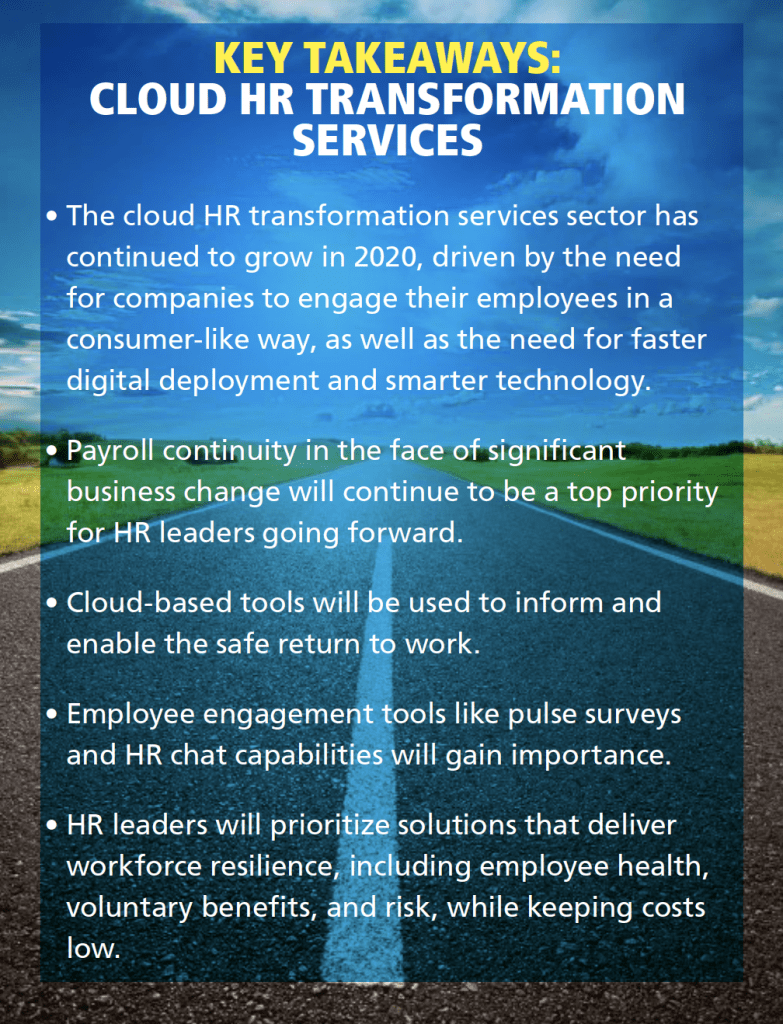 The drive to digital has kept many cloud HR transformation projects on track in 2020 despite the delay of some large enterprise signings. The challenges facing organizations this year relate to workforce safety, productivity, security, cost containment alongside deepening cost pressures, and a need to ensure all processes are digital. In this climate, success pivots on organizations’ ability to be agile and drive restructures to support significant market upheavals, as well as their ability to adapt to rapidly changing and challenging compliance needs.
The drive to digital has kept many cloud HR transformation projects on track in 2020 despite the delay of some large enterprise signings. The challenges facing organizations this year relate to workforce safety, productivity, security, cost containment alongside deepening cost pressures, and a need to ensure all processes are digital. In this climate, success pivots on organizations’ ability to be agile and drive restructures to support significant market upheavals, as well as their ability to adapt to rapidly changing and challenging compliance needs.
Cloud HR transformation services are adjusting to a fluid work-life era defined by greater people engagement to support individual needs in a consumer-like way, while addressing higher speed digital deployment through improved use of automation and technology to better manage the speed of business change and industry consolidation.
2021 HR Outlook: Cloud HR Transformation Services
Drivers expected from the cloud HR transformation services market in 2021 include:
- Managing workforce restructuring and HR and payroll compliance. With unprecedented layoffs and furloughs in some industries contrasting with significant growth in other industries, HR has played a key role in supporting the business through change. Ensuring a smooth payroll process was as the biggest operational management priority in 2020, and payroll will continue to be a critical HR activity for organizations going forward.
- Workplace tools to enable workplace change. With employees working from home, a greater focus on worker tracking will support the safe return to work, enabling touchless workplace services, social distancing interactions, and contact tracing.
- Effective employee engagement is table stakes. Employees will have diverse needs and individual personal demands, requiring greater HR flexibility and more tailored employee solutions. Enabling tools such as HR chat, regular employee surveys, and employee pulse checks to support improved engagement will increase in importance.
- Security. As the workforce adjusts to remote work and the prevalence of cyber-attacks continues to increase, cybersecurity is increasingly important.
- Greater resilience. Cost improvements, digital processes, and agility are also key to HR delivery models. Priorities are expected to focus more greatly on solutions that help make workforces more resilient, including employee health, voluntary benefits, and risk. Companies will be looking for greater agility for changing business needs. In the light of COVID-related revenue and cash flow challenges across many industries, it is expected there will be a heavier focus on delivering longer-term cost improvements.
Benefits Administration in 2020
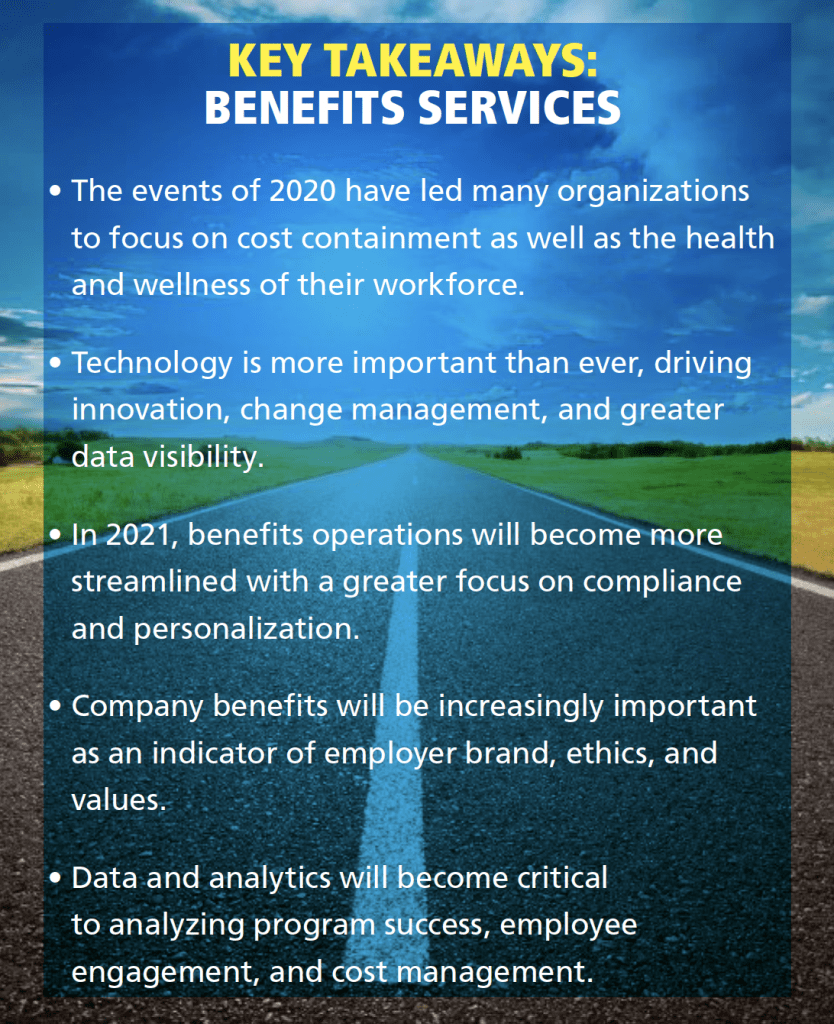 In 2020, benefits administration providers have continued to focus on expanding benefits offerings tailored to specific needs while minimizing administration by improving processes and technology. The events of this year have driven many organizations to be more focused on cost containment as well as the health and welfare of their employees.
In 2020, benefits administration providers have continued to focus on expanding benefits offerings tailored to specific needs while minimizing administration by improving processes and technology. The events of this year have driven many organizations to be more focused on cost containment as well as the health and welfare of their employees.
However, significant changes in the way of working have impacted the industry. For example, benefits fairs were managed online versus in-person for the first time this year. Furthermore, technology is now much more of a driving force to innovation, either through homegrown platforms or managed acquisitions and tighter partnerships, as a way to support changing client needs and demands for greater data visibility.
Buyers of benefits programs continue to expect greater flexibility to support change, greater automation, customizations of communications, and improved process efficiencies. As government relief packages introduced by most major governments greatly impacted health provision and benefits rules, operations had to adapt quickly to apply these changes. As a result, 2020 has been a year of increased operational costs for many benefits administrators.
2021 HR Outlook: Benefits Services
Drivers expected from the benefits administration services market in 2021 include:
- Automation and integration. Benefits operations will become more streamlined with greater integrations, minimizing risk and manual interventions.
- Rising health costs. Costs might have reduced in 2020 due to the lower number of medical claims; however, a high cost spike is expected in 2021 due to pent up demand for health services.
- Compliance challenges. Keeping up with relief legislation has been challenging, and more changes are expected in 2021. The dynamic nature of the benefits market will mean more buyers will look to expert providers for guidance and support, bringing greater agility to support compliance.
Compliance, security, and risk management will grow in importance, especially as more processes are moved online and as companies capture more data about their employees.
- Personalization will rise. Personalization through AI will grow alongside company ethics and brand as it relates to benefits design. AI will increasingly support benefit recommendation engines; personalization will also increase through more fine-tuned communication tools.
- Benefits will be a key differentiator. Benefit design will have a growing importance in promoting diversity in workplaces and representing the company brand.
- Roles will evolve. Benefits professionals’ roles will change to become more focused on marketing and communicating benefit programs, and less focused on interface/error management and processing.
- Industrialize and institutionalize analytics. Organizations will increasingly use data to support and evaluate program success, employee engagement, cost management, and drive more informed decision making.
Payroll Services in 2020
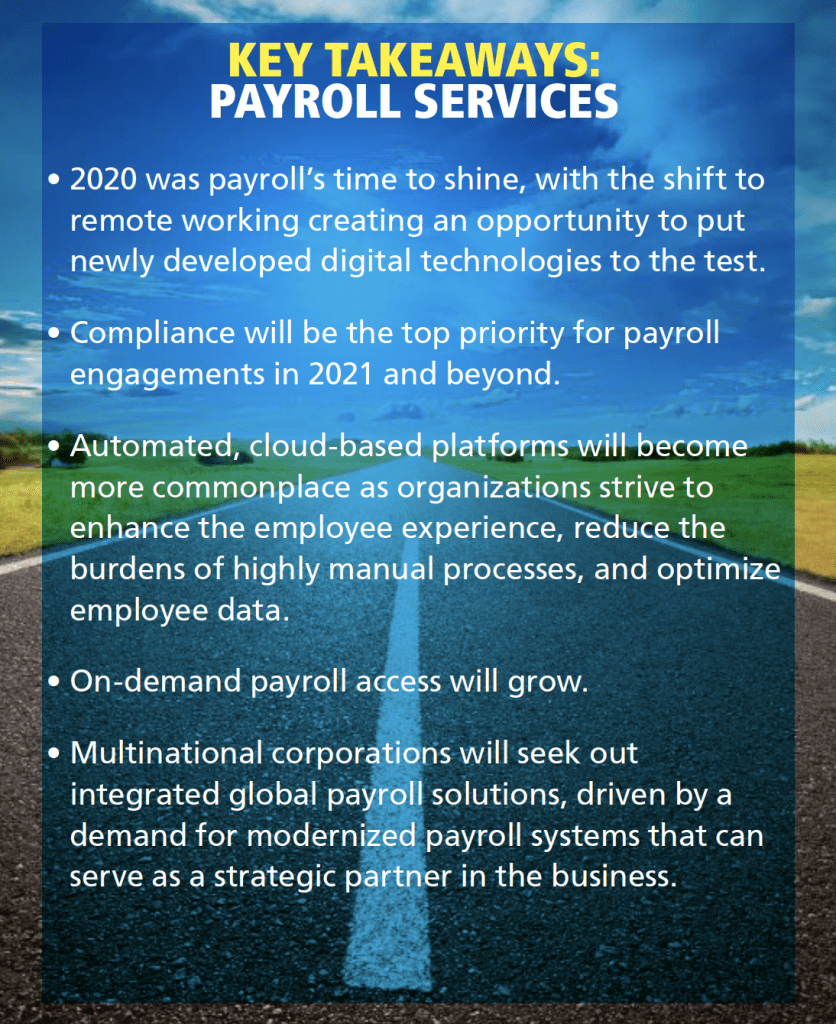 This past year has been a stark wake up call for many organizations as it pertains to their payroll operations. The aftereffects of the pandemic strained and exposed operating models up and down market, leaving many firms across sectors realizing that investments to future-proof payroll operations for greater resiliency can no longer wait.
This past year has been a stark wake up call for many organizations as it pertains to their payroll operations. The aftereffects of the pandemic strained and exposed operating models up and down market, leaving many firms across sectors realizing that investments to future-proof payroll operations for greater resiliency can no longer wait.
At the same time, 2020 has been payroll’s time to shine, with practitioners stepping up to answer the call and keep workers around the globe paid timely and accurately during arguably one of the most challenging moments in recent history, despite the shortfalls in capability.
On the managed services front, the shift to work from home enabled payroll providers to put their digital technologies to the test, proving out the very solutions they had been proliferating in recent years and urging buyers to focus on cloud platform adoption, mobile-first design, on-demand payroll capability, predictive analytics, and dynamic integrations that bring it all together seamlessly.
Additionally, firms operating in managed payroll services arrangements had much-needed help in quickly accessing reliable data, interpreting compliance directives, and responding to government support programs. They ultimately fared better in navigating the unforeseen challenges, reinforcing the value of managed payroll services.
2021 HR Outlook: Payroll Services
While payroll service provider revenues were negatively impacted by the global economic downturn and subsequent job loss, with buying decisions put on hold, the appetite for digital payroll solutions and managed services is quite healthy and growing into 2021.
With payroll a core element in the employee experience, global footprints creeping, and compliance risks rapidly intensifying, buyers are keenly focused on payroll as a key area of investment moving ahead, and thus service provider pipelines are healthy, signaling a gradual return to the growth levels experienced before the pandemic.
Five key themes and drivers can be expected from the managed payroll services market in 2021:
- Compliance is the top priority. Compliance is quite possibly the leading driver for managed payroll services adoption today and one that will intensify moving forward; buyers will focus on tapping into the tools, localizations, expertise, and global capability that partners can offer at scale in removing risk and ensuring complete and timely compliance as statutory requirements evolve.
- Digitalization up and down the process. No process in the employee lifecycle has been historically more neglected or overlooked than payroll. Partners will continue leveraging cloud platforms as the launchpad to enable deeper digital capabilities, with a heavy emphasis on automating the highly manual process through robotic process automation (RPA), AI, and machine learning (ML) infusion, inching toward eventual fully autonomous processing. With payroll sitting squarely at the heart of the employee experience and wellness, look for deeper mobile capabilities, expanded use cases for AI and ML, and natural language processing (NLP)-enabled virtual assistants that augment users and personalize experiences with guided, predictive insights to drive best practices and data-driven decision making.
- On-demand earned wage access will be a game-changer for payroll. If the pandemic taught HR anything, it’s just how vital and impactful the ability to move earned wages to employees in a timely fashion can be. With the employee experience, engagement, and wellness top of mind for today’s business leaders, on-demand payroll capability helps by empowering employees with greater control and insight over their earnings. Look for the solution to continue its hypergrowth trajectory in the U.S. and Canada, but increasing slowly internationally.
- Payroll becomes a strategic partner. Payroll has long been viewed as a simple processor and cost center, often overlooked in key HR decision making or strategic decisions. Yet payroll controls one of the most critical processes in the employee lifecycle and houses some of the most under utilized and generally misunderstood data sets in the entire organization. With the continued proliferation and criticality of globally consolidated predictive analytics and benchmarking capabilities paired with the advancements in digitalization, payroll has the opportunity to truly shift its focus toward becoming a strategic advisor to the business.
- Multi-country deals will escalate. With many multinational corporations operating on legacy, disparate, and often poorly integrated payroll solutions, the appetite for consolidating and modernizing global payroll remains strong, particularly with many firms finding their global operating models ill-equipped to handle the next major disruption. With multi-country payroll solutions able to support 100+ countries on average, look for buyers to tap into vendor offerings that can consolidate, digitize, and automate payroll globally through a single solution.
Global EoR Services
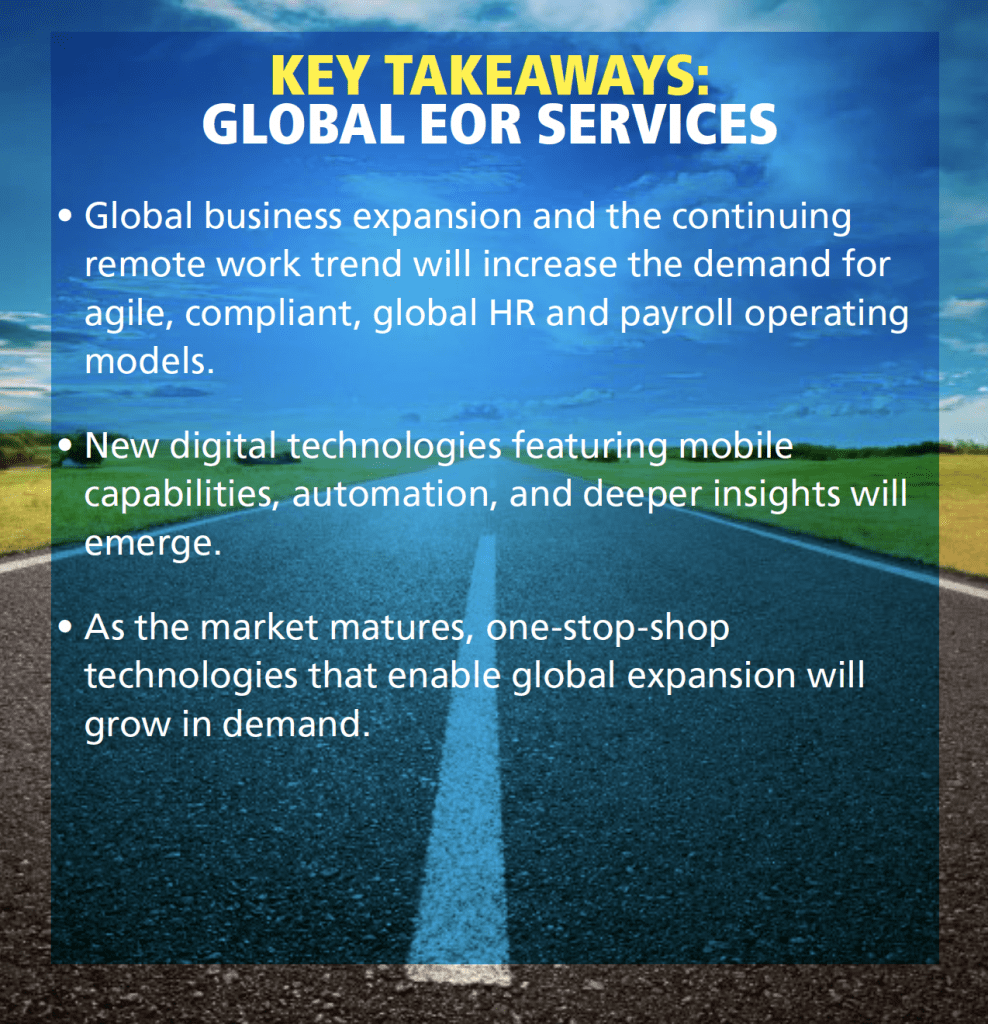 While co-employment service models have historically been U.S.-centric, global co-employment offerings have emerged, providing multinational firms a highly agile, turnkey support model for rapid, compliant, international expansion.
While co-employment service models have historically been U.S.-centric, global co-employment offerings have emerged, providing multinational firms a highly agile, turnkey support model for rapid, compliant, international expansion.
Also commonly referred to as “global PEO” or “international PEO” services, they facilitate international expansion by leveraging vendor established legal entities and pre-defined country-specific contracts to employ workers in new countries of operation where the organization lacks the proper business nexus, expertise, and capability to operate in full compliance.
This service model is particularly effective at enabling HR with greater speed and agility in supporting strategic business initiatives, leading to a competitive advantage for growth-focused multinational firms seeking to expand their footprints globally, test emerging markets, or access talent outside of their home country of operation.
2021 HR Outlook: Global EoR Services
As organizations of all sizes find their brands expanding internationally and companies across sectors demand to access top talent globally, particularly as the work from anywhere trend continues breaking down talent access barriers, the demand for agile, compliant, global HR and payroll operating models will continue to intensify, accelerating the global EoR services market size toward more than $1 billion by 2024.
North American headquartered firms will remain the predominant adopter of global EoR services, while Europe and Asia will provide strong pipelines for new client and new worker growth as the top targets for expansion by both external and regionally based firms.
Look for enabling technology platforms across the global EoR services marketplace to mature in the coming 12 to 24 months, particularly as differentiation in the space is commonly centered on the volume of entities under a service provider’s control, level of in-country expertise, and the overall customer or worker experience.
Expect to see increasing investments by partners maturing, developing, and offering digital enablers and capabilities, including mobile-first design, deeper process automation, infusion of AI, and analytic insights. And as the solution gains traction and adoption, expect to see a deeper focus by partners in cultivating a technology-enabled, one-stop-shop of global expansion-enabling solutions.
Pete Tiliakos is an HR Technology and Services Research Director at NelsonHall.
Liz Rennie is an HR Technology and Services Principal Research Analyst at NelsonHall.
Nikki Edwards is an HR Technology and Services Principal Research Analyst at NelsonHall.














